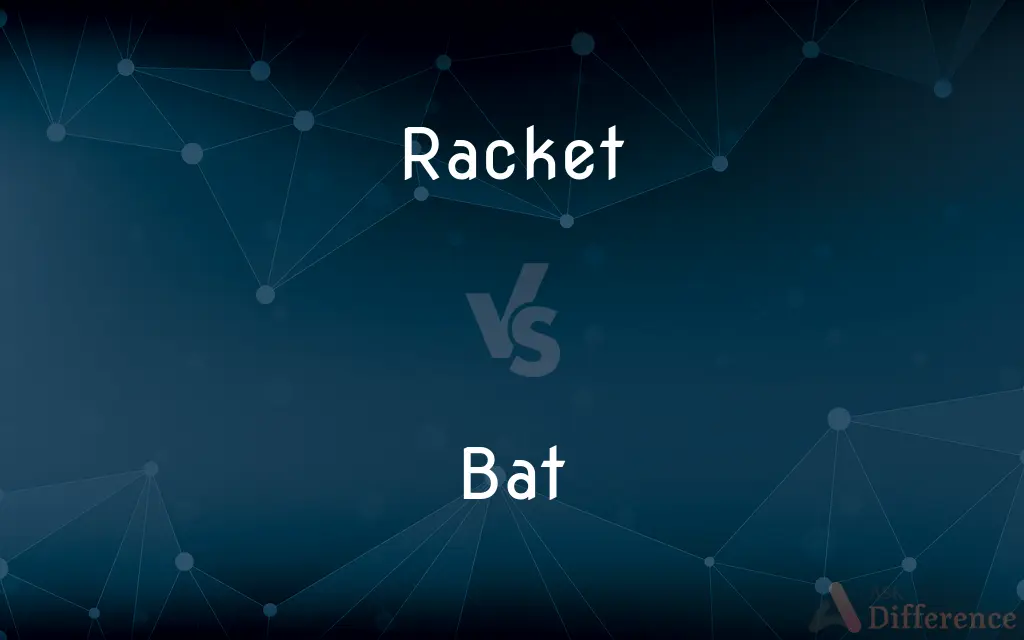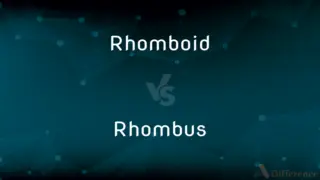Racket vs. Bat — What's the Difference?
By Tayyaba Rehman & Maham Liaqat — Updated on March 4, 2024
A racket is used in sports like tennis with a netted string area, while a bat is solid, used in games like baseball.

Difference Between Racket and Bat
Table of Contents
ADVERTISEMENT
Key Differences
Rackets are designed for sports where the ball is hit back and forth over a net, such as tennis, badminton, and squash. They have a long handle and a large head with a string mesh that provides a surface for striking the ball. The design of a racket is crucial for providing control, power, and the ability to spin the ball. Whereas bats are used in sports like baseball, cricket, and table tennis, consisting of a solid structure without any strings. Bats are primarily designed to hit a ball in one direction, and their shape and material are optimized for power, control, and speed of the ball after impact.
Rackets often require a specific technique to use effectively, focusing on wrist movement, precision, and timing to control the ball's direction and speed. The skills needed to use a racket involve a combination of strength, agility, and coordination to manage the game's pace. On the other hand, using a bat involves more straightforward swinging motions aimed at maximizing impact force. The technique for bats emphasizes timing, power, and accuracy to ensure the ball is hit as intended.
The materials used in making rackets and bats also differ significantly. Rackets are usually made from lightweight materials like carbon fiber, aluminum, and graphite to allow for quick movements and provide durability. These materials contribute to the racket's ability to absorb shock and transfer energy efficiently to the ball. Bats, in contrast, are made from wood or metal, depending on the sport. Wooden bats are traditional in sports like baseball and cricket, offering a classic feel and flexibility, while metal bats are common in recreational leagues for their durability and lighter weight.
The evolution of rackets and bats over time reflects changes in the sports they are used for. Rackets have become lighter and larger, with advanced materials enhancing performance and reducing injuries. Innovations in string technology and racket shape have also allowed players to develop new styles of play. Bats have seen changes in material and design, with regulations in professional sports often dictating specifications to ensure fair competition and player safety.
The choice between a racket and a bat depends on the sport being played. Each is specialized for its respective games, with designs that reflect the unique requirements and skills needed. While rackets offer a blend of precision and versatility in racket sports, bats provide the power and control needed in bat sports. Both are essential tools for their respective games, each with a rich history of development and innovation.
ADVERTISEMENT
Comparison Chart
Use in Sport
Tennis, badminton, squash
Baseball, cricket, table tennis
Structure
Long handle, large head with a string mesh
Solid, varying shapes depending on the sport
Material
Carbon fiber, aluminum, graphite
Wood, metal (aluminum or alloy)
Technique
Wrist movement, precision, timing
Swinging motion, timing, power
Evolution
Lighter, larger, advanced materials for performance
Changes in material for durability, regulated designs
Compare with Definitions
Racket
A tool used in racket sports with a netted string area to hit a ball.
She swung her racket with precision to win the point in tennis.
Bat
Optimized for power, control, and speed of the ball after impact.
The design of his cricket bat helped him drive the ball further.
Racket
Made from lightweight materials like carbon fiber for quick movements.
Her new carbon fiber racket significantly improved her game.
Bat
Used in sports where the aim is to hit a ball in one direction.
A quality bat is essential for a baseball player's performance.
Racket
Essential for sports requiring ball striking back and forth over a net.
Choosing the right racket is crucial for a badminton player's success.
Bat
A solid piece of equipment used to hit a ball in sports like baseball.
He hit a home run with his wooden bat in the final inning.
Racket
Designed for control and spin, with a long handle and string mesh.
The lightweight racket allowed him to easily control the ball's direction.
Bat
Typically made from wood or metal, depending on the sport.
Metal bats are popular in amateur baseball for their light weight.
Racket
Has become lighter and larger, with innovations enhancing performance.
Modern rackets are designed to reduce injuries and enhance play.
Bat
Material and design changes influenced by regulations for fairness.
The evolution of bats in cricket has led to more exciting games.
Racket
A bat with a round or oval frame strung with catgut, nylon, etc., used especially in tennis, badminton, and squash
A squash racket
Bat
An implement with a handle and a solid surface, typically of wood, used for hitting the ball in games such as cricket, baseball, and table tennis
A cricket bat
Racket
A device consisting of an oval or circular frame with a tight interlaced network of strings and a handle, used to strike a ball or shuttlecock in various games.
Bat
(of a sports team or player) take the role of hitting rather than throwing the ball
Australia reached 263 for 4 after choosing to bat
Racket
An implement with a handle connected to a round frame strung with wire, sinew, or plastic cords, and used to hit a ball, such as in tennis or a birdie in badminton.
Bat
A club used in cricket, having a broad, flat-surfaced hitting end and a distinct, narrow handle.
Racket
To strike with, or as if with, a racket.
Bat
To hit with or as if with a bat.
Racket
A thin strip of wood, having the ends brought together, forming a somewhat elliptical hoop, across which a network of catgut or cord is stretched. It is furnished with a handle, and is used for catching or striking a ball in tennis and similar games.
Each one [of the Indians] has a bat curved like a crosier, and ending in a racket.
Bat
A turn at hitting the ball with a bat in a game.
You've been in for ages. Can I have a bat now?
Racket
A variety of the game of tennis played with peculiar long-handled rackets; - chiefly in the plural.
Bat
To use a bat, as in a game of baseball; when used with a numerical postmodifier it indicates a baseball player's performance (as a decimal) at bat; as, he batted .270 in 1993 (i.e. he got safe hits in 27 percent of his official turns at bat).
Racket
A sports implement (usually consisting of a handle and an oval frame with a tightly interlaced network of strings) used to strike a ball (or shuttlecock) in various games
Bat
(baseball) a turn batting;
He was at bat when it happened
He got 4 hits in 4 at-bats
Racket
Hit (a ball) with a racket
Bat
A bat used in playing cricket
Common Curiosities
Can the material of a racket or bat affect gameplay?
Yes, the material can significantly impact performance, with rackets being lightweight for quick movements and bats being sturdy for power.
What makes bats different from rackets?
Bats are solid and used in sports where the goal is to hit a ball in one direction, unlike rackets, which have a netted string area.
What is the primary use of a racket?
A racket is primarily used in sports like tennis, badminton, and squash to hit a ball back and forth over a net.
How have rackets evolved over time?
Rackets have become lighter and larger, with materials and design innovations enhancing performance and reducing injuries.
Why are bats made from wood or metal?
The choice depends on the sport's tradition and the desired balance of durability and performance, with wood offering a classic feel and metal providing lighter weight.
What advancements have been made in racket technology?
Advancements include the use of carbon fiber and other lightweight materials, as well as innovations in string technology.
How do regulations affect bat design in professional sports?
Regulations ensure fairness and player safety, dictating specifications like material and dimensions.
What role does the shape of a bat play in its effectiveness?
The shape affects the bat's balance, the ease of swinging, and the power and direction of the ball after impact.
Why might a player choose a wooden bat over a metal one?
A player might prefer the traditional feel and flexibility of wood, especially in professional leagues where it's standard.
What skills are necessary for effectively using a racket?
Skills include strength, agility, coordination, and the ability to manage the game's pace.
Are there sports where both rackets and bats are used?
No, sports typically specialize in using either a racket or a bat, not both.
Is technique important when using a racket or bat?
Yes, each requires specific techniques; rackets need wrist movement and timing, while bats require power and accuracy.
How does the design of a racket assist in sports like tennis?
The string mesh and shape of the racket provide control, power, and the ability to spin the ball.
Can a bat be used in a racket sport, or vice versa?
No, each is specialized for its respective sports and using one in place of the other would be impractical and against the rules.
How do personal preferences influence the choice of racket or bat?
Personal preferences can dictate the weight, material, and design of the equipment, affecting comfort, play style, and performance.
Share Your Discovery

Previous Comparison
Geek vs. Seek
Next Comparison
Rhomboid vs. RhombusAuthor Spotlight
Written by
Tayyaba RehmanTayyaba Rehman is a distinguished writer, currently serving as a primary contributor to askdifference.com. As a researcher in semantics and etymology, Tayyaba's passion for the complexity of languages and their distinctions has found a perfect home on the platform. Tayyaba delves into the intricacies of language, distinguishing between commonly confused words and phrases, thereby providing clarity for readers worldwide.
Co-written by
Maham Liaqat













































